As per Adobe 2019 Consumer survey, 51% of customers will likely make a purchase and 49% of customers will be loyal to the brand if the content is more personalized. So the AEM 6.5 release is customer focussed. It delivers innovation that enables marketers and IT professionals to collaborate on the rapid delivery of personalized brand experience – exactly when & where they are expected.
It is easy for key features to get lost in the huge list of what’s new & better. To help you out, here are the top 10 AEM 6.5 features.
1. Connected DAM (Digital Asset Management)
A Digital Asset Management (DAM) platform gives you a central hub for organizing, storing, and retrieving rich media. AEM Sites offer capabilities to create web pages and AEM Assets in the DAM system that supplies the required assets for websites.
AEM now provides the capability to use assets from a connected DAM which is running in a completely different AEM instance.
In a large scale enterprise, there may be two AEM instances running in parallel. A common scenario where this happens is when one instance is used as an AEM Site Author, executed by the AEM Site Team, while the second instance is used by the creative team to store assets, referred to as Assets Author instance. With a connected DAM, Site authors can search, drag & drop, save, and publish assets directly even though the asset is on a different instance. It allows site authors to access from remote AEM assets instance.
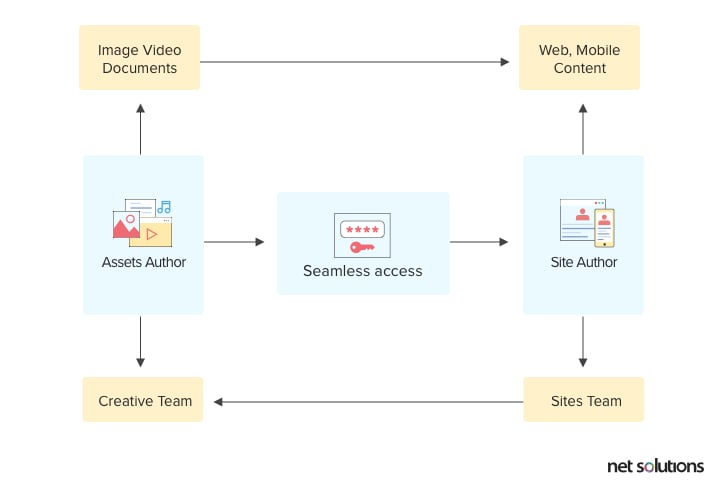
It offers unified, easy-to-use access to all owned assets, no matter where they are stored.
This is ideal for a growing number of businesses that need a central, standalone DAM with AEM Assets.
Limitations:
This feature is only supported on Adobe Managed Services.
The AEM site can connect with only one AEM asset repository.
A license is required for a remote Asset repository.
There is no API support to customize the integration.
A Digital Asset Management (DAM) platform gives you a central hub for organizing, storing, and retrieving rich media. AEM Sites offer capabilities to create web pages and AEM Assets in the DAM system that supplies the required assets for websites.
AEM now provides the capability to use assets from a connected DAM which is running in a completely different AEM instance.
In a large scale enterprise, there may be two AEM instances running in parallel. A common scenario where this happens is when one instance is used as an AEM Site Author, executed by the AEM Site Team, while the second instance is used by the creative team to store assets, referred to as Assets Author instance. With a connected DAM, Site authors can search, drag & drop, save, and publish assets directly even though the asset is on a different instance. It allows site authors to access from remote AEM assets instance.

It offers unified, easy-to-use access to all owned assets, no matter where they are stored.
This is ideal for a growing number of businesses that need a central, standalone DAM with AEM Assets.
Limitations:
This feature is only supported on Adobe Managed Services.
The AEM site can connect with only one AEM asset repository.
A license is required for a remote Asset repository.
There is no API support to customize the integration.
2. Adobe Asset Link Extension with AEM Assets
With this enhancement, the collaboration between creatives and marketers will strengthen in the content creation process. It will make it very easy for marketers to find the right assets which are to be used in creative workflows. Here are a few top business benefits of Asset link:
The direct in-app panel ensures creatives never leave the creative context to access digital assets which are stored in Adobe Experience Manager.
Relevant assets can be universally searched and viewed from AEM Assets and Creative Cloud Assets.
Ability to check a digital asset out of and back into AEM to prevent duplicate work by the team.
Ability to keep Work-in-Progress assets and final production assets in separate locations.
Easy access through Single Sign-on with your Creative Cloud account credentials.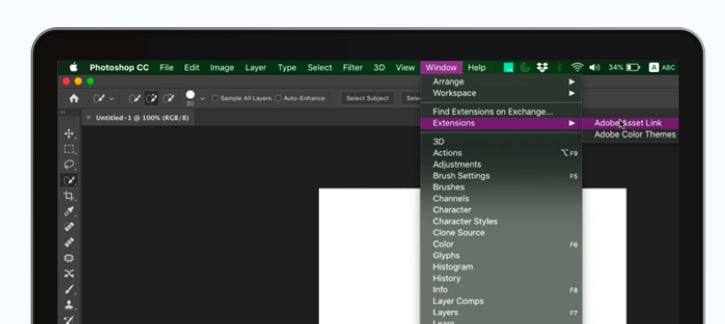
Using this feature, which is supported in Creative Cloud 2018 and 2019, a creator who is working in the Adobe Creative Cloud applications like Photoshop, Illustrator, or InDesign has an option to connect to AEM Assets using Adobe Asset Link. This will streamline creatives' and marketers' workflows in the content creation process.
3. Integrate Adobe Assets with Adobe Stocks
Adobe Stock provides millions of high-quality 3D assets, templates, videos, illustrations, vectors, etc. for creative projects. Now Adobe Stock Enterprise plan within AEM Assets ensures that all licensed assets are available for creatives and marketers. With this integration, Adobe Stock's licensed assets can be saved in DAM using powerful capabilities of AEM.
Some top benefits for creators & marketers are:
Users can quickly find, preview, and license stock Assets from Adobe Stock, and then Save them to Adobe Assets.
Once an Adobe Stock asset is licensed in AEM, you can use and manage it like a typical Asset.
Users can license Adobe Stock assets by using the quota of their Adobe Stock Enterprise plan.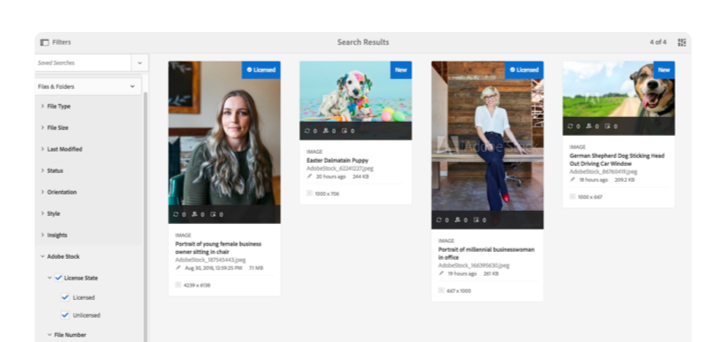
This Integration can be performed by AEM Administrators and Admin Console Administrator since it requires Administrative privileges.
4. Brand Portal Capabilities
Brand Portal is a cloud application. This is useful for practitioners who want to share some assets with their agencies or who want to share a portal with their partner but at the same time don’t want to give them access of DAM. Following are the list of enhancements:
Upload capability on the brand portal for sourcing brand, campaign assets from external agencies & teams.
Publish to DAM for review and multi-channel campaign usage.
New contributor role for an external agency user persona.
Direct folder share with an external agency from DAM.
Admin configurations to control upload sizes.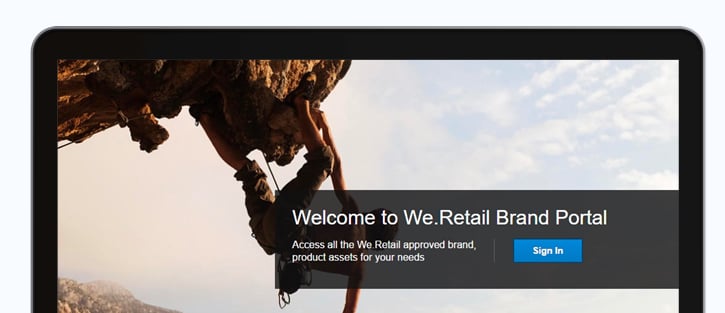
5. Adobe Experience Manager SPA (Single Page Application) Editor
By using AEM SPA (Single Page Application) Editor, developers can easily build web sites using the SPA Framework and authors can seamlessly edit content within AEM. It is recommended to use the SPA Editor if your project requires a SPA framework-based client-side rendering (e.g React or Angular).
SPA Editors are more powerful in AEM 6.5 with multi-site management. Now the content author can leverage the AEM 6.5 capability to manage React/Angular SPA within AEM.
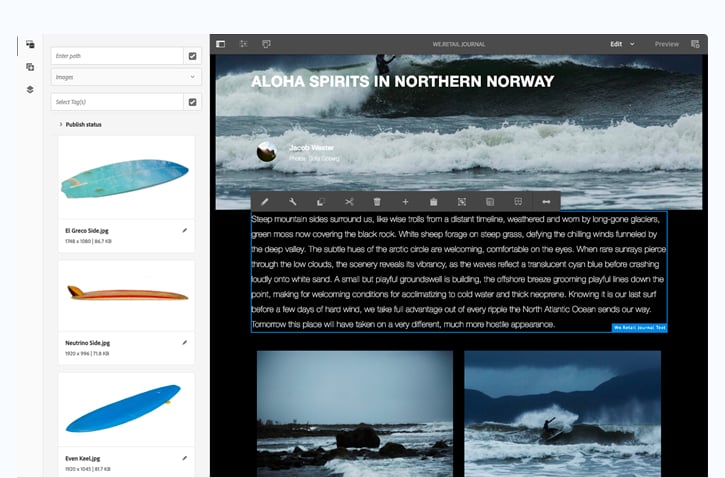
Following features have been added in AEM 6.5:
In-context preview and edit of React and Angular SPA
Server-side rendering of SPA to reduce first page load time and improve SEO.
It can be extended with the AEM SJ SDK to be made editable for practitioners.
Use the Template Editor to edit and configure the AEM editable parts of the SPA.
You can use Multi-site Management to create a country, franchise, or white-labeled SPA experience.
Localization and translation support for SPA now.
Features are added to embed forms and communications from AEM Forms into SPA Editors.
With this enhancement, the collaboration between creatives and marketers will strengthen in the content creation process. It will make it very easy for marketers to find the right assets which are to be used in creative workflows. Here are a few top business benefits of Asset link:
The direct in-app panel ensures creatives never leave the creative context to access digital assets which are stored in Adobe Experience Manager.
Relevant assets can be universally searched and viewed from AEM Assets and Creative Cloud Assets.
Ability to check a digital asset out of and back into AEM to prevent duplicate work by the team.
Ability to keep Work-in-Progress assets and final production assets in separate locations.
Easy access through Single Sign-on with your Creative Cloud account credentials.

Using this feature, which is supported in Creative Cloud 2018 and 2019, a creator who is working in the Adobe Creative Cloud applications like Photoshop, Illustrator, or InDesign has an option to connect to AEM Assets using Adobe Asset Link. This will streamline creatives' and marketers' workflows in the content creation process.
3. Integrate Adobe Assets with Adobe Stocks
Adobe Stock provides millions of high-quality 3D assets, templates, videos, illustrations, vectors, etc. for creative projects. Now Adobe Stock Enterprise plan within AEM Assets ensures that all licensed assets are available for creatives and marketers. With this integration, Adobe Stock's licensed assets can be saved in DAM using powerful capabilities of AEM.
Some top benefits for creators & marketers are:
Users can quickly find, preview, and license stock Assets from Adobe Stock, and then Save them to Adobe Assets.
Once an Adobe Stock asset is licensed in AEM, you can use and manage it like a typical Asset.
Users can license Adobe Stock assets by using the quota of their Adobe Stock Enterprise plan.

This Integration can be performed by AEM Administrators and Admin Console Administrator since it requires Administrative privileges.
4. Brand Portal Capabilities
Brand Portal is a cloud application. This is useful for practitioners who want to share some assets with their agencies or who want to share a portal with their partner but at the same time don’t want to give them access of DAM. Following are the list of enhancements:
Upload capability on the brand portal for sourcing brand, campaign assets from external agencies & teams.
Publish to DAM for review and multi-channel campaign usage.
New contributor role for an external agency user persona.
Direct folder share with an external agency from DAM.
Admin configurations to control upload sizes.

5. Adobe Experience Manager SPA (Single Page Application) Editor
By using AEM SPA (Single Page Application) Editor, developers can easily build web sites using the SPA Framework and authors can seamlessly edit content within AEM. It is recommended to use the SPA Editor if your project requires a SPA framework-based client-side rendering (e.g React or Angular).
SPA Editors are more powerful in AEM 6.5 with multi-site management. Now the content author can leverage the AEM 6.5 capability to manage React/Angular SPA within AEM.

Following features have been added in AEM 6.5:
In-context preview and edit of React and Angular SPA
Server-side rendering of SPA to reduce first page load time and improve SEO.
It can be extended with the AEM SJ SDK to be made editable for practitioners.
Use the Template Editor to edit and configure the AEM editable parts of the SPA.
You can use Multi-site Management to create a country, franchise, or white-labeled SPA experience.
Localization and translation support for SPA now.
Features are added to embed forms and communications from AEM Forms into SPA Editors.
6. Smart Crop
Prior to the release of Adobe Experience Manager 6.5, to fit into multiple layouts, you needed multiple sizes of each image in your design to suit each target screen size. With a website incorporating hundreds or thousands of images, this simply wasn’t practical. Adobe Sensei based Smart Crop features allow you to overcome this situation. With a smart crop, all your images are cropped automatically within the Experience Manager. There is no need for any other tool.
Some key features of this feature are:
Videos/images are automatically cropped to new aspect ratios while preserving the points of interest.
This powerful feature helps practitioners in working out a responsive design where there are multiple variations of the same image to suit different size requirements in the marketing campaign.
All images are automatically cropped in the folder where workflow is applied.
Smart Crop editing layout can also be sized for better visibility.
Published URL for the Smart Corp asset can be used for 3rd party applications that accept hosted assets.
Smart Crop option can be set up, for the target size you want, and you have the option to review the changes without affecting the other images in the folder.
AEM Site’s Dynamic Media component also supports Smart Corp.
Prior to the release of Adobe Experience Manager 6.5, to fit into multiple layouts, you needed multiple sizes of each image in your design to suit each target screen size. With a website incorporating hundreds or thousands of images, this simply wasn’t practical. Adobe Sensei based Smart Crop features allow you to overcome this situation. With a smart crop, all your images are cropped automatically within the Experience Manager. There is no need for any other tool.
Some key features of this feature are:
Videos/images are automatically cropped to new aspect ratios while preserving the points of interest.
This powerful feature helps practitioners in working out a responsive design where there are multiple variations of the same image to suit different size requirements in the marketing campaign.
All images are automatically cropped in the folder where workflow is applied.
Smart Crop editing layout can also be sized for better visibility.
Published URL for the Smart Corp asset can be used for 3rd party applications that accept hosted assets.
Smart Crop option can be set up, for the target size you want, and you have the option to review the changes without affecting the other images in the folder.
AEM Site’s Dynamic Media component also supports Smart Corp.
7. Visual Search
Visual search is an Adobe Sensei powered search capability to find visually similar assets in the DAM.
Adobe Sensei powers intelligent features across all Adobe Products to dramatically improve the design and delivery of the digital experience using Artificial Intelligence, Machine Learning, and Deep Learning. Visual Search is also powered by Adobe Sensei, which identifies the content and composition of your image — and automatically adds meta Tags to instantly deliver search results based on the visual information.
You don’t need to translate a visual to text to search. You simply need to drag and drop an image into the search bar and Visual Search will tag, search, and deliver similar images.
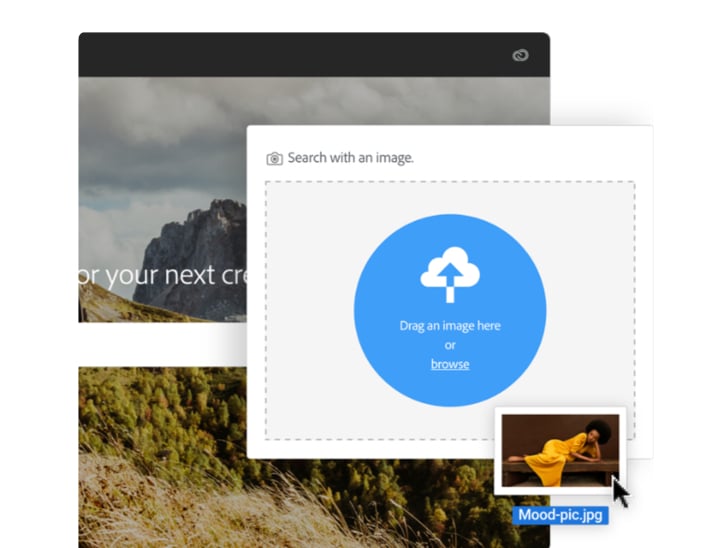
8. Headless Content Delivery
Up to AEM 6.4, you needed to create a Content Fragment Model which is converted into the content fragment. This content fragment was placed on AEM pages using Sling Model to export in JSON format. AEM 6.5 simplifies the process.
In AEM 6.5, the HTTP API now supports the delivery of content fragments. All you have to do is create Content Fragment and then leverage the Asset HTTP API to export it in JSON format. It can be easily invoked by attaching “API/assets/” in the content fragment URL.
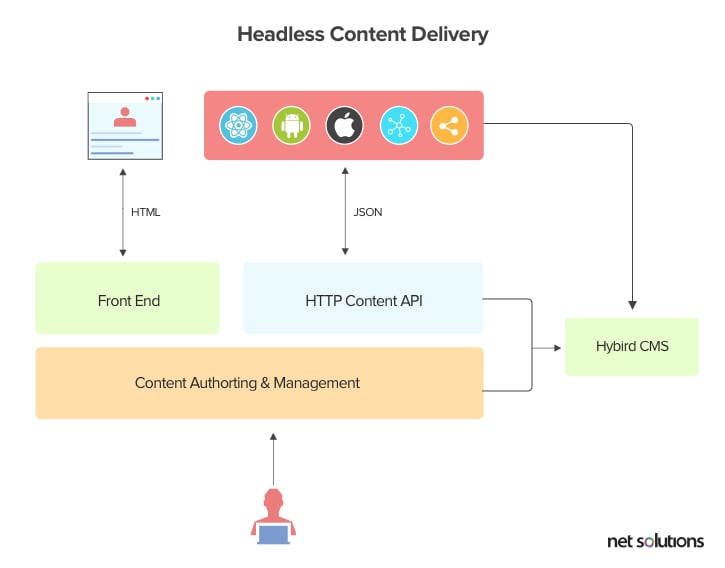
This JSON format can be consumed across SPA, Mobile App, iOS App, and more. We have written about headless CMS and how it is better than traditional CMS previously.
9. Automated Forms Conversion
Adobe Sensei powers you to automatically convert all your legacy PDF forms and traditional input fields to digital, mobile-responsive, adaptive forms. With AEM 6.5, AEM Forms author can leverage the following capabilities:
Forms rendered properly, no matter what devices your customers use.
You also have an option to convert batches of forms at once, and easily connect with analytics and preconfigure themes to make a brand consistent.
You can extract fragments and components that you can reuse for creating new forms. So, you don’t need to worry to create new components for each form.
Form structures extracted by identifying form sections, texts, fields and semantically mapping them to appropriate fields, types or groups.
Automated post-processing the form structure and logical groupings help build data schema to facilitate back-end data integration, along with applying consistent branding, styling, common navigation, logic, and validations.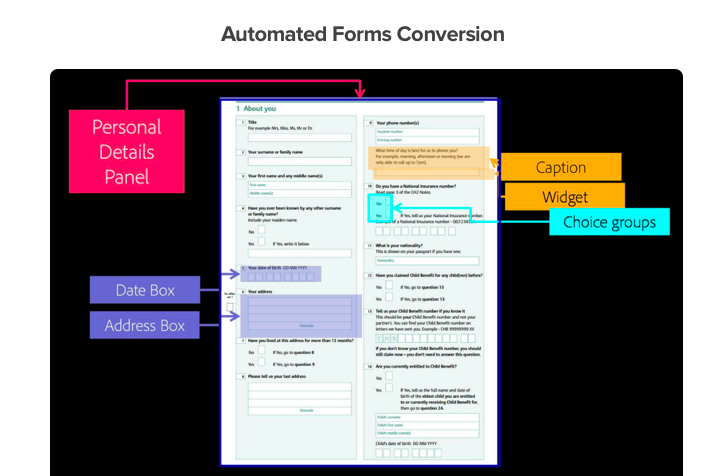
This approach significantly reduces the time taken to digitize and modernize the end to end data capture experience, especially for organizations that have dozens and hundreds of legacy PDF forms that they need to convert.
10. Reusing Workflow Across Multiple Adaptive Forms
Till AEM 6.4, there was no concept of reusability of form workflows. Each workflow was tied to an adaptive form, so you had to create different workflows for different forms even if the workflow model was the same.
To solve the problem, AEM 6.5 has introduced the same workflow across an adaptive form. Forms author can dynamically select the form associated with the workflow. This way, users can reuse workflow processes across multiple forms. It is achieved by Assign Task steps, which can be configured so that it can be automatically bound to particular adaptive forms.
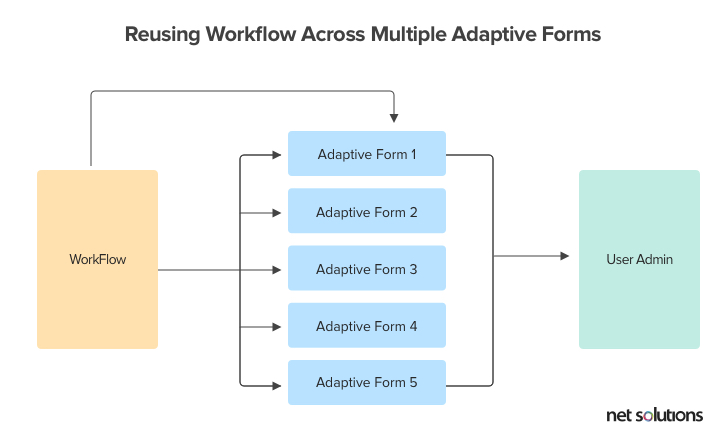
Conclusion
Adobe Experience Manager 6.5 release delivers innovation that enables marketers & IT professionals to collaborate on the rapid delivery of the personalized brand experience. In this release Adobe Sensei powers many features that help you to identify customer behavior, use those thoughts to serve relevant and personalized experience.
There are many features like smart crop, visual search, Automated Forms Conversion, etc. which help to deliver the right content, to the right audience at the right time with better customer experience.
Visual search is an Adobe Sensei powered search capability to find visually similar assets in the DAM.
Adobe Sensei powers intelligent features across all Adobe Products to dramatically improve the design and delivery of the digital experience using Artificial Intelligence, Machine Learning, and Deep Learning. Visual Search is also powered by Adobe Sensei, which identifies the content and composition of your image — and automatically adds meta Tags to instantly deliver search results based on the visual information.
You don’t need to translate a visual to text to search. You simply need to drag and drop an image into the search bar and Visual Search will tag, search, and deliver similar images.

8. Headless Content Delivery
Up to AEM 6.4, you needed to create a Content Fragment Model which is converted into the content fragment. This content fragment was placed on AEM pages using Sling Model to export in JSON format. AEM 6.5 simplifies the process.
In AEM 6.5, the HTTP API now supports the delivery of content fragments. All you have to do is create Content Fragment and then leverage the Asset HTTP API to export it in JSON format. It can be easily invoked by attaching “API/assets/” in the content fragment URL.

This JSON format can be consumed across SPA, Mobile App, iOS App, and more. We have written about headless CMS and how it is better than traditional CMS previously.
9. Automated Forms Conversion
Adobe Sensei powers you to automatically convert all your legacy PDF forms and traditional input fields to digital, mobile-responsive, adaptive forms. With AEM 6.5, AEM Forms author can leverage the following capabilities:
Forms rendered properly, no matter what devices your customers use.
You also have an option to convert batches of forms at once, and easily connect with analytics and preconfigure themes to make a brand consistent.
You can extract fragments and components that you can reuse for creating new forms. So, you don’t need to worry to create new components for each form.
Form structures extracted by identifying form sections, texts, fields and semantically mapping them to appropriate fields, types or groups.
Automated post-processing the form structure and logical groupings help build data schema to facilitate back-end data integration, along with applying consistent branding, styling, common navigation, logic, and validations.

This approach significantly reduces the time taken to digitize and modernize the end to end data capture experience, especially for organizations that have dozens and hundreds of legacy PDF forms that they need to convert.
10. Reusing Workflow Across Multiple Adaptive Forms
Till AEM 6.4, there was no concept of reusability of form workflows. Each workflow was tied to an adaptive form, so you had to create different workflows for different forms even if the workflow model was the same.
To solve the problem, AEM 6.5 has introduced the same workflow across an adaptive form. Forms author can dynamically select the form associated with the workflow. This way, users can reuse workflow processes across multiple forms. It is achieved by Assign Task steps, which can be configured so that it can be automatically bound to particular adaptive forms.

Conclusion
Adobe Experience Manager 6.5 release delivers innovation that enables marketers & IT professionals to collaborate on the rapid delivery of the personalized brand experience. In this release Adobe Sensei powers many features that help you to identify customer behavior, use those thoughts to serve relevant and personalized experience.
There are many features like smart crop, visual search, Automated Forms Conversion, etc. which help to deliver the right content, to the right audience at the right time with better customer experience.
No comments:
Post a Comment
If you have any doubts or questions, please let us know.